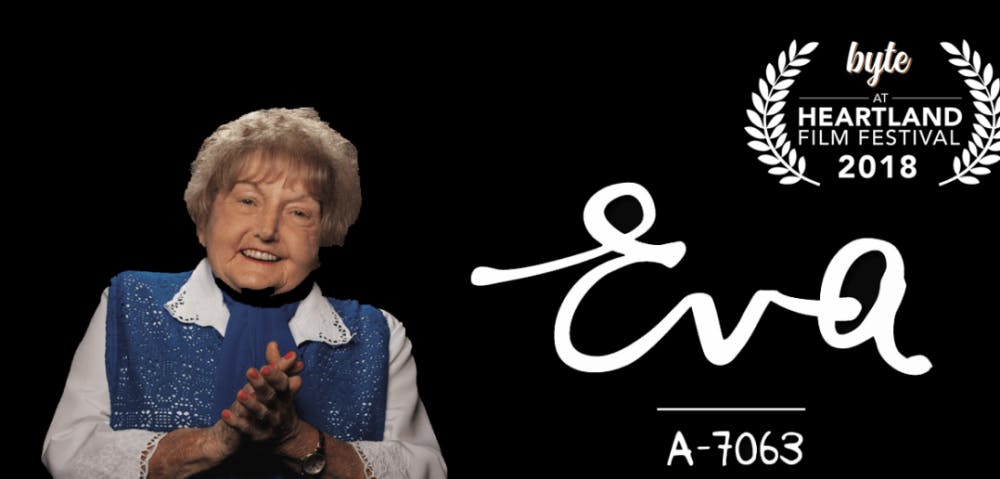For the 2018-19 school year, most high school seniors were born in 2000 or 2001. This means that the incoming class of college freshmen will be the first higher education class to have a substantial number of students born after the events of Sept. 11, 2001. With this set of circumstances, these people will not likely have the strong emotional ties to the event that others who were alive during the event have. For many who want to keep the memory of 9/11 alive in the collective consciousness of Americans everywhere, this presents new challenges.
Similarly, the people who were youngest during the second World War and the Holocaust are dying, with those who were children during WWII reaching their 80s. This being the case, it is important to make accounts of the Holocaust and to hear the stories of survivors.
Surviving the Mengele
Eva chronologically follows the life and experiences of Eva Mozes Kor. When she was just 10 years old, Eva was taken from her home in Porț, Romania to Auschwitz along with her twin sister Miriam, parents, and two other siblings. Immediately, she was taken along with Miriam to a separate part of the camp where the “Angel of Death” Dr. Josef Mengele performed experiments on Jewish twins to unlock the secrets of creating more perfect Germans faster.
Having been injected with unknown substances in experiments and after years of stealing food to survive, Eva and Miriam were found by the Russian army when they freed the remaining survivors from the camp. Eva and Miriam can even be seen holding hands at the front of a line of children being filmed for Russian propaganda.
Afterward Eva moved to Terre Haute, Indiana after living in Israel, feeling frequently angry because of what had happened to her and her family. As an adult, Eva helped revive interest in finding Dr. Josef Mengele, who had evaded capture and had been living in hiding for decades after the war ended. Eva became an international figure again when she made the controversial decision late in her life to publicly forgive not just Mengele but also every single Nazi. This personal decision understandably raised a lot of controversy and ire within the Holocaust survivor community. Now her life is devoted to her own Holocaust museum, CANDLES, which operates in Eva’s home of Terre Haute.
Friends, family, and other survivors
Throughout the course of the film, in addition to interviews with Eva herself, many others are given a chance to express their opinions, such as other survivors of Auschwitz, including a pair of twin sisters who were also subject to Mengele’s sadistic experiments. The range of people who talk about how Eva has affected their lives is stunning. Included in the cast is CNN reporter Wolf Blitzer, Executive director at Steven Spielberg’s Shoah Foundation Dr. Stephen Smith, famed Holocaust historian Dr. Michael Berenbaum, and many, many more. The variety and acclaim of the people appearing in the documentary are a testament to the effect that Eva has and on the quality of the documentary.
One of the most interesting subjects is Eva’s son, who grew up in the house that was vandalized with swastikas and who saw how his mother’s experiences affected her. At the point the film where Eva started saying that in refusing to forgive the Nazis, other Holocaust survivors were being “good little victims.” The film immediately shows an interview with her son where he says, “And I think that was very selfish and wrong of her.” In juxtaposing Eva’s statements with her son’s condemnation of her views, the documentary showed that it was willing to make substantial criticisms of Eva and to boldly address the controversy that Eva fostered throughout her life.
The ultimate in forgiveness
Eva’s son was not the only person featured in the documentary whose ideas conflicted with Eva. The climax of the documentary lands firmly in Eva’s decision to extend forgiveness to the Nazis who killed her family and experimented on her. Other survivors are shown reacting to her stance, with the anguish of their suffering radiating from their faces. One survivor emphatically repeats, “Six million people. Six million people,” emphasizing the tremendous loss that the Jewish community worldwide faced in the wake of the Holocaust. Regardless, Eva maintains that her forgiveness is hers alone to give.
In addition, the people who knew her throughout her life were able to attest to a marked change in her demeanor after she made her decision to forgive. People from her son to a college professor of hers and others all note that Eva seemed to be a more peaceful, emotionally healthy person- that she had the immense weight she had accrued over the years lifted off her shoulders.
Eva then made it her mission to communicate her message of radical forgiveness to others. Her message has touched the lives of other victims of genocide, sexual assault victims, and many others who needed to hear it. Eva Kor makes yearly trips to Auschwitz, touring the campus where she once struggled with her sister. In one of the most emotionally affecting lines of the film, Eva states, “I return here not as a victim but as a triumphant survivor!” By ending on this message, Eva’s complicated life story is given a perfect narrative ending: fulfillment through forgiveness. The emotional storytelling was able to examine the life of a controversial figure with clarity and balance rarely seen in biopics.
“Never forget.” That has become the mournful rallying cry of a world of mourners in the wake of the multitude of horrors imposed by the Nazis. The aphorism is not solely about remembering those who were lost but maybe moreso about nor forgetting the lessons learned as people confronted the Holocaust. Eva Mozes Kor has a message that should never be forgotten, and this film is the perfect vehicle for that message.

Featured Image: The Story of Eva



















